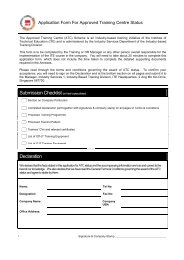Higher Nitec in Civil & Structural Engineering Design - Institute of ...
Higher Nitec in Civil & Structural Engineering Design - Institute of ...
Higher Nitec in Civil & Structural Engineering Design - Institute of ...
You also want an ePaper? Increase the reach of your titles
YUMPU automatically turns print PDFs into web optimized ePapers that Google loves.
SCHOOL OF ENGINEERING<br />
MODULE OBJECTIVES<br />
Core Modules<br />
Aircraft General Ma<strong>in</strong>tenance<br />
On completion <strong>of</strong> the module, students should be able to<br />
perform aircraft general ma<strong>in</strong>tenance such as fasten<strong>in</strong>g, wirelock<strong>in</strong>g,<br />
sealant application, corrosion control <strong>of</strong> components<br />
and plumb<strong>in</strong>g; rivet<strong>in</strong>g and surface crack <strong>in</strong>spection; update<br />
ma<strong>in</strong>tenance records and documentation.<br />
Aircraft Draw<strong>in</strong>g<br />
On completion <strong>of</strong> the module, students should be able to <strong>in</strong>terpret<br />
aircraft bluepr<strong>in</strong>t draw<strong>in</strong>gs, aircraft manuals and catalogues<br />
prepare component draw<strong>in</strong>g and pattern development.<br />
Human Factors<br />
On completion <strong>of</strong> the module, students should be able to<br />
perform occupational safety, health and environment checks and<br />
to m<strong>in</strong>imize human factor error <strong>in</strong> aircraft ma<strong>in</strong>tenance.<br />
Aircraft Electrical and Electronics System<br />
On completion <strong>of</strong> the module, students should be able to <strong>in</strong>terpret<br />
wir<strong>in</strong>g circuits, carry out term<strong>in</strong>ation <strong>of</strong> electrical wires, replace<br />
wire looms, use and calibrate measur<strong>in</strong>g and test<strong>in</strong>g <strong>in</strong>struments,<br />
and perform rout<strong>in</strong>e ma<strong>in</strong>tenance on AC/DC mach<strong>in</strong>es and<br />
aircraft electrical systems.<br />
Aircraft Instrumentation System<br />
On completion <strong>of</strong> the module, students should be able to perform<br />
rout<strong>in</strong>e ma<strong>in</strong>tenance and operational test on pitot-static system,<br />
synchro, pressure and temperature systems, eng<strong>in</strong>e <strong>in</strong>dicat<strong>in</strong>g<br />
system, magnetic compass system, auto-pilot system, oxygen<br />
system, electronic display system, stall warn<strong>in</strong>g system and flight<br />
record<strong>in</strong>g system.<br />
Basic Aircraft Materials and Aerodynamics<br />
On completion <strong>of</strong> the module, students should be able to repair<br />
m<strong>in</strong>or surface defects <strong>of</strong> aircraft sheet metal, repair corroded<br />
sheet metal.<br />
Aircraft Radio Communication System<br />
On completion <strong>of</strong> the module, students should be able to perform<br />
rout<strong>in</strong>e ma<strong>in</strong>tenance and operational test on radio communication<br />
system, aircraft audio system, aircraft radio navigation system,<br />
aircraft radar system and measure voltage stand<strong>in</strong>g wave ratio<br />
<strong>of</strong> an antenna.<br />
Aircraft Ma<strong>in</strong>tenance Practice<br />
Students will undergo a 6-month On-the-Job Tra<strong>in</strong><strong>in</strong>g (OJT) course<br />
with aerospace <strong>in</strong>dustry to re<strong>in</strong>force the skills and knowledge<br />
acquired at the tra<strong>in</strong><strong>in</strong>g <strong>in</strong>stitute and to develop competencies <strong>in</strong><br />
other specialized areas.<br />
Life Skills Modules<br />
Life skills <strong>in</strong> broad terms are the foundation skills and personal<br />
qualities that an <strong>in</strong>dividual can transfer from one job sett<strong>in</strong>g to<br />
another to manage and adapt to changes <strong>in</strong> technology and<br />
work environments.<br />
Electives (Course Specific)<br />
TIG Weld<strong>in</strong>g<br />
On completion <strong>of</strong> the module, students should be able to jo<strong>in</strong><br />
sheet metal and rebuild metal us<strong>in</strong>g TIG weld<strong>in</strong>g process.<br />
Non Destructive Test<strong>in</strong>g<br />
On completion <strong>of</strong> the module, students should be able to<br />
understand the work<strong>in</strong>g pr<strong>in</strong>ciples <strong>of</strong> non-destructive test<strong>in</strong>g<br />
(NDT) methods used for detect<strong>in</strong>g defects <strong>in</strong> the aircraft<br />
components/structures.<br />
Robotic Fundamental<br />
On completion <strong>of</strong> the module, students should be able to<br />
programme an <strong>in</strong>dustrial robot to perform tasks such as pick and<br />
place and sort<strong>in</strong>g <strong>of</strong> parts, plan robot operations and troubleshoot<br />
common and simple robot application system faults.<br />
Basic Pr<strong>in</strong>ciple <strong>of</strong> Helicopter<br />
On completion <strong>of</strong> the module, students should be able to<br />
understand the basic pr<strong>in</strong>ciples <strong>of</strong> aerodynamics <strong>in</strong> helicopters<br />
and the various types <strong>of</strong> rotors used to achieve lift. They should<br />
also be able to identify the various parts <strong>of</strong> the helicopter and<br />
mechanism and controls used <strong>in</strong> chang<strong>in</strong>g <strong>of</strong> blade pitch.<br />
Metrology<br />
On completion <strong>of</strong> the module, students should be able to<br />
<strong>in</strong>spect, verify and measure eng<strong>in</strong>eer<strong>in</strong>g components accord<strong>in</strong>g<br />
to technical draw<strong>in</strong>g us<strong>in</strong>g appropriate tools.<br />
Composite Structure Repairs<br />
On completion <strong>of</strong> the module, students should be able to perform<br />
cold and hot bond<strong>in</strong>g on honeycomb structures us<strong>in</strong>g fibreglass<br />
wet and epoxy res<strong>in</strong> material (cold bond<strong>in</strong>g) and wet lay up prepreg,<br />
metal sk<strong>in</strong> materials and foam core material. Students will<br />
also be tra<strong>in</strong>ed on <strong>in</strong>spection <strong>of</strong> damaged structures and post<br />
bond<strong>in</strong>g <strong>in</strong>spection and test<strong>in</strong>g.<br />
Electives (General)<br />
As reflected on page 26.<br />
237



![[CHOICE] - Institute of Technical Education](https://img.yumpu.com/23578991/1/184x260/choice-institute-of-technical-education.jpg?quality=85)

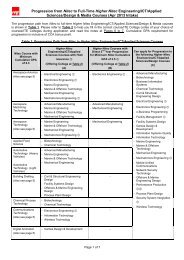

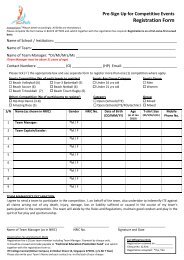
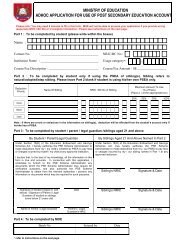
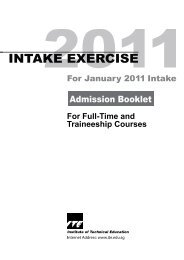



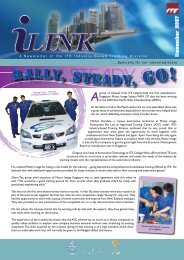
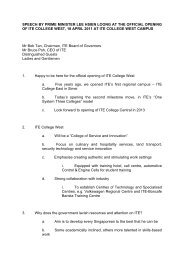
![FAQs for Full-time Nitec Jan 2012 Intake [JIE 'N']](https://img.yumpu.com/23578955/1/190x245/faqs-for-full-time-nitec-jan-2012-intake-jie-n.jpg?quality=85)
